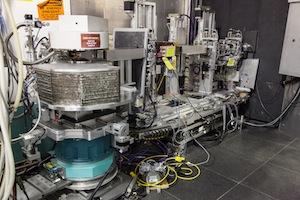
These devices work through magnetoresistance, a quantum mechanical effect observed about 20 years ago in thin-film structures. The effect is observed as a significant change in electrical resistance depending on whether the magnetization of adjacent ferromagnetic layers is in parallel or antiparallel alignment.
“What we are doing here is developing new materials. The search for new materials suitable for injecting and transferring carriers with a preferential spin orientation is most important for the development of spintronics,” says Valeria Lauter, lead instrument scientist for the SNS Magnetisim Reflectometer (MR), who collaborated on the experiment.
New research indicates that for these devices an organic polymer semiconductor layer between the magnetic materials improves the conductivity of such materials. Organic semiconductors are now the material of choice for future spin valve devices. They preserve spin-coherence over longer times and distances than conventional semiconductors. Although research into spin valves has been ongoing, research into organic semiconductors is recent.
Previous research has shown that a “conductivity mismatch” exists in spin valve systems in which ferromagnetic metal electrodes interface with such organic semiconductors as Alq3 (π-conjugated molecule 8-hydroxy-quinoline aluminum). This mismatch limits the efficient injection of the electrons from the electrodes at the interface with the semiconductor material. Lithium Fluoride (LiF), commonly used in light-emitting diodes, is known to enhance the injection of electrons through the semiconductor.
Researchers from the University of Alabama and ORNL used polarized neutrons at the MR to investigate the electronic, magnetic, and structural properties of the electrodes in a novel system, where the magnetic layers cobalt and Ni80Fe20 interface with spacer-layers composed of the organic semiconductor Alq3. A coupling layer of LiF is inserted to separate the magnetized layers from the semiconductor.
“ALQ3 is an organic semiconductor material,” says Lauter. “Normally in these systems a first magnetic layer is grown on a hard substrate so that one can get the controlled magnetic parameters. Then you grow the organic semiconductor layer, followed by another magnetic material layer, such as cobalt.
In addition to determining the effect of the LiF layers on the efficiency of the electron injection, the researchers wanted to determine the magnetic properties of the cobalt and the Ni80Fe20, as well as the interfacial properties_for example, whether there is interdiffusion of cobalt through the LiF layer to the semiconductor.
The researchers used polarized neutrons at the MR to probe the entire, layer-by-layer assembly of the system. “Reflectometry with polarized neutrons is a perfect method to study thin-magnetic films,” Lauter says. “These thin films, if you put one on a substrate, you see it just like a mirror. However, this mirror has a very complicated internal multilayer structure. The neutrons look inside this complicated structure and characterize each and every interface. Due to the depth sensitivity of the method, we measure the structural and magnetic properties of each layer with the resolution of 0.5 nm.”
The neutron scattering results found that inserting LiF as a barrier significantly improves the quality of the interface, increasing the injection of electrons from the magnetic layer through the organic semiconductor in the spin valve and enhancing the overall properties of the system. In related work, the magnetic properties of the cobalt film and the permalloy Ni80Fe20 were characterized. Cobalt in particular needed attention, as it cannot be grown epitaxially (i.e., deposited) on an organic semiconductor film. Cobalt becomes polycrystalline or amorphous, and this affects its magnetic properties.
The data from the first experiment showed that the cobalt layer in the system “did not have nominal cobalt properties,” Lauter says. “The results showed that the cobalt had low magnetization. To improve the efficiency, the cobalt magnetization should be much higher. So this experiment helped us to improve the growth conditions and to get a cobalt layer with better magnetic properties.”
In a subsequent experiment, the researchers increased the magnetization of the cobalt, and a followup paper is in progress.
This research was funded by the U.S. Department of Energy (DOE) Office of Basic Energy Sciences.

